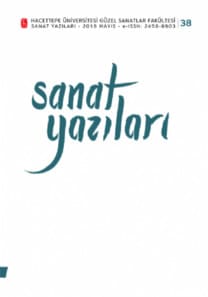PROTESTONUN SEBEBİ VE ENSTRÜMANI OLARAK GÜNCEL SANAT
20. yüzyılın tüm önemli olayları -İkinci Dünya Savaşı, Soğuk Savaş, Vietnam işgali, ulusal kurtuluş savaşları, 1968 devrimci ayaklanmaları- sanat alanında da yankılandı. Sanatçıların protestoculara evrildiği birçok girişim bu dönemden günümüze şekillendi. Sanatçılar toplumdaki eşitsizliklere dikkat çekmek için mücadele ederken ve bunun için sanatı doğrudan bir eylem metodu olarak kullanırken kurumları sorunsallaştırdılar ve kendi komünitelerini değiştirmeye çalıştılar. Neoliberal ekonomilerin ve yönetimlerin yükselişiyle müzelerde protesto son kırk yılda rutin haline geldi; kültür endüstrisi çalışanları, amaçları ve yöntemleri farklı olmasına rağmen, neoliberal rejimler tarafından üretilen sanat kurumlarının sorunlarına ışık tutmaya kararlı bir şekilde güncel sanatı protestoya dönüştürürken, protestoyu da estetikleştirdiler. Bu makale, sanat kurumunu kamusal mekân ve tartışma ortamı olarak ele alarak, bu alana karşı ve bu alan sayesinde oluşan kimi çağdaş müdahaleleri incelemektedir. Hangi kamusal alanlarda ve kimler tarafından bu müdahalelerin gerçekleştirildiği araştırılarak; ortak araç ve motivasyonlar, hangi sanatsal ve politik söylemlerin geliştirildiği anlaşılmaya çalışılmakta; kültür sürecine tabandan yapılan müdahalelerin izi sürülmektedir.
CONTEMPORARY ART AS THE REASON AND INSTRUMENT OF PROTEST
All the social and political occurrences of 20th century -World War II, Cold War, occupation of Vietnam, the national liberation wars, uprisings of 1968- resounded in arts. Initiatives where artists evolved into protestors, took action from then on. As artists drew attention to the injustices in society and adapted art as direct action, they also problematized institutions. With the rise of neo-liberal regimes, protests at the museums became routine in past four decades; individuals of the culture industry who are determined to shed light to complications of art establishments transformed contemporary art into protest, while aestheticizing protest itself. This article considers art institution as public space and a place of dispute, analysing some contemporary case movements opposed to and by means of it. Investigating initiatives, it is attempted to understand common means and motivations, which artistic instruments are being used; tracing grassroots interventions in the cultural context
___
Adorno, Theodor W. (1998). Aesthetic Theory. (R. Hullot-Kentor, Çev.). Minneapolis, MN: University Of Minnesota Press.Adorno, T. W., Horkheimer, M. (2007). Dialectic of Enlightenment. (E. Jephcott, Çev.). Redwood City, CA: Stanford University Press.
Collazo, Julie Schwietert. (2017). Occupy Museums Hosts a Faux Graduation Ceremony at the Whitney Museum. Hyperallergic. Erişim: 02.11.2019. https://hyperallergic. com/377721/occupy-museums-hosts-a-faux-graduation-ceremony-at-the-whitney-museum/
Fischer, Noah. (2011). Occupy Museums Manifesto (OWS). noah fischer. Erişim: 02.11.2019. http://www.noahfischer.org/view/manifesto/38396
Fischer, N., Žmijewski, A. (2014). The Occupied Museum. Artleaks Gazette, 2, s. 7-26.
Gielen, Pascal. (2013). Introduction: When flatness rules. Pascal Gielen (Ed.), Institutional Attitudes: Instituting Art in a Flat World, s. 1-7. Amsterdam: Valiz.
Gulf Labor Artist Coalition. Erişim: 02.11.2019. https://gulflabor.org/faq/
Kamusal Sanat Laboratuvarı. Erişim: 02.11.2019. http://kamusalsanatlaboratuvari.blogspot .com.tr/p/isimsiz-mektup
Kamusal Sanat Laboratuvarı. Erişim: 02.11.2019. https://kamusalsanatlaboratuvari. blogspot.com/p/manifesto.html
Kamusal Sanat Laboratuvarı. Erişim: 02.11.2019. http://kamusalsanatlaboratuvari.blogspot. com/p/muzecinin-cantas.html
Kompatsiaris, Panos. (2015). Art Struggles: Confronting Internships and Unpaid Labour in Contemporary Art. tripleC, 13/2, s. 554-566.
Küçük, Cihan. (2016). Sunuş / Müze Politikalarına Karşı: Occupy Museums, Liberate Tate,
Gulf Labor. e-skop. Erişim: 02.11.2019. https://www.e-skop.com/skopdergi/sunus-muze-politikalarina-karsi-occupy-museums-liberate-tate-gulf-labor/3154
Liberate Tate. Erişim: 02.11.2019. http://www.liberatetate.org.uk/liberating-tate/
Liberate Tate. Erişim: 02.11.2019. http://www.liberatetate.org.uk/performances/
Liberate Tate. Erişim: 02.11.2019. http://www.liberatetate.org.uk/performances/the-gift/
Marx, Karl. (1969). Theories of Surplus Value Part I. (E. Burns, Çev.). Moskova: Progress Publishers.
Muñoz-Alonso, Lorena. (2015). ‘Art Not Oil’ Activists Stage Protests Across Four Major London Museums. artnet news. Erişim: 02.11.2019. https://news.artnet.com/art-world/activists-protests-london-museums-332258
Nadine, M. Kalın. (2015). The occupation of art museum educator in the time of Occupy Museums. International Journal of Education through Art, 11/2, s. 299-309.
Novick, Ilana. (2017). “Art is the Ultimate Con”: Should Artists Occupy Museums?. GARAGE. Erişim: 02.11.2019. https://garage.vice.com/en_us/article/9kqpwy/coco-fusco-noah-fischer-pioneer-works
Sholette, Gregory. (2011). Dark Matter: Art and Politics in the Age of Enterprise Culture. London: Pluto Press.
Schubert, Karsten. (2000). The Curator’s Egg : The evolution of the museum concept from the French Revolution to the present day. London: One-Off Press.
Scott, Anthony Oliver. (2014). The Paradox of Art as Work. The New York Times. Erişim: 02.11.2019. https://www.nytimes.com/2014/05/11/movies/the-paradox-of-art-as-work. html
Sickler, Erin. (2012). Art and the 99%. Art in America, 100/1, s. 31–32.
Wasik, John. (2017). Why college loans are the worst debt. CBS News. Erişim: 02.11.2019. https://www.cbsnews.com/news/forget-bad-debt-college-loans-are-the-worst-debt/
Wilson, Julia Bryan. (2009). Art Workers: Radical Practice in the Vietnam War Era. Berkeley: University of California Press.
- ISSN: 2458-8903
- Yayın Aralığı: Yılda 2 Sayı
- Başlangıç: 2001
- Yayıncı: -
Sayıdaki Diğer Makaleler
TİYATRODAN RESİM VE FOTOĞRAFA: BERTOLT BRECHT’İN YABANCILAŞTIRMA EFEKTİNİN YÜZEYDEKİ OLASILIKLARI
PROTESTONUN SEBEBİ VE ENSTRÜMANI OLARAK GÜNCEL SANAT
SANAT VE SANATÇI BAĞLAMINDA YAPAY ZEKÂ RESİMLERİ
TANER CEYLAN’IN KAYIP RESİMLERİNDE YALNIZLIK
SÜRREALİST SİNEMANIN SÜRREALİST AFİŞLERİ: TERRY GILLIAM FİLM AFİŞLERİNİN GÖSTERGEBİLİMSEL ANALİZİ
SANAT ESERLERİ ARACILIĞIYLA ESTETİKTE GÜZEL KAVRAMININ İNCELENMESİ
OFİS YAPILARINDAKİ SOSYAL AMAÇLI ORTAK ALANLARDA İNSAN FAKTÖRÜ ÜZERİNE BİR ARAŞTIRMA
